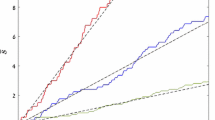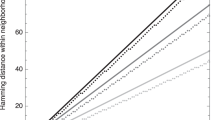Abstract
Cell populations can benefit from changing phenotype when the environment changes. One mechanism for generating these changes is stochastic phenotype switching, whereby cells switch stochastically from one phenotype to another according to genetically determined rates, irrespective of the current environment, with the matching of phenotype to environment then determined by selective pressure. This mechanism has been observed in numerous contexts, but identifying the precise connection between switching rates and environmental changes remains an open problem. Here, we introduce a simple model to study the evolution of phenotype switching in a finite population subject to random environmental shocks. We compare the successes of competing genotypes with different switching rates, and analyze how the optimal switching rates depend on the frequency of environmental changes. If environmental changes are as rare as mutations, then the optimal switching rates mimic the rates of environmental changes. If the environment changes more frequently, then the optimal genotype either maximally favors fitness in the more common environment or has the maximal switching rate to each phenotype. Our results also explain why the optimum is relatively insensitive to fitness in each environment.
Similar content being viewed by others
References
Acar, M., Mettetal, J. T., & van Oudenaarden, A. (2008). Stochastic switching as a survival strategy in fluctuating environments. Nat. Genet., 40, 471–475.
Avery, S. V. (2006). Microbial cell individuality and the underlying sources of heterogeneity. Nat. Rev., Microbiol., 4, 577–587.
Balaban, N. Q., Merrin, J., Chait, R., Kowalik, L., & Leibler, S. (2004). Bacterial persistence as a phenotypic switch. Science, 305, 1622–1625.
Ben-Porath, E., Dekel, E., & Rustichini, A. (1993). On the relationship between mutation rates and growth rates in a changing environment. Games Econ. Behav., 5, 576–603.
Bürger, R., Willensdorfer, M., & Nowak, M. A. (2006). Why are phenotypic mutation rates much higher than genotypic mutation rates? Genetics, 172, 197–206.
Cohen, D. (1966). Optimizing reproduction in a randomly varying environment. J. Theor. Biol., 12, 119–129.
DeWitt, T. J., Sih, A., & Wilson, D. S. (1998). Costs and limits of phenotypic plasticity. Trends Ecol. Evol., 13, 77–81.
Donaldson-Matasci, M. C., Lachmann, M., & Bergstrom, C. T. (2008). Phenotypic diversity as an adaptation to environmental uncertainty. Evol. Ecol. Res., 10, 493–515.
Fiedler, M. (1986). Special matrices and their applications in numerical mathematics. Dordrecht: Martinus Nijhoff.
Foster, D., & Young, P. (1990). Stochastic evolutionary game dynamics. Theor. Popul. Biol., 38, 219–232.
Freidlin, M. I., & Wentzell, A. D. (1998). Random perturbations of dynamical systems (2nd ed.). New York: Springer.
Fudenberg, D., & Harris, C. (1992). Evolutionary dynamics with aggregate shocks. J. Econ. Theory, 57, 420–441.
Fudenberg, D., & Imhof, L. A. (2006). Imitation processes with small mutations. J. Econ. Theory, 131, 251–262.
Fudenberg, D., & Imhof, L. A. (2008). Monotone imitation dynamics in large populations. J. Econ. Theory, 140, 229–245.
Fudenberg, D., & Levine, D. K. (1998). The theory of learning in games. Cambridge: MIT Press.
Fudenberg, D., Nowak, M. A., Taylor, C., & Imhof, L. A. (2006). Evolutionary game dynamics in finite populations with strong selection and weak mutation. Theor. Popul. Biol., 70, 352–363.
Gillespie, J. H. (1974). Natural selection for within-generation variance in offspring number. Genetics, 76, 601–606.
Harmer, G. P., & Abbott, D. (2002). A review of Parrondo’s paradox. Fluct. Noise Lett., 2, R71–R107.
Ibba, M., & Söll, D. (1999). Quality control mechanisms during translation. Science, 286, 1893–1897.
Imhof, L. A., Fudenberg, D., & Nowak, M. A. (2005). Evolutionary cycles of cooperation and defection. Proc. Natl. Acad. Sci. USA, 102, 10797–10800.
Ishii, K., Matsuda, H., Iwasa, Y., & Sasaki, A. (1989). Evolutionarily stable mutation rate in a periodically changing environment. Genetics, 121, 163–174.
Jablonka, E., Oborny, B., Molnár, I., Kisdi, É., Hofbauer, J., & Czárán, T. (1995). The adaptive advantage of phenotypic memory in changing environments. Philos. Trans. R. Soc. Lond. Ser. B, 350, 133–141.
Kandori, M., Mailath, G. J., & Rob, R. (1993). Learning, mutation, and long run equilibria in games. Econometrica, 61, 29–56.
Kimura, M. (1967). On the evolutionary adjustment of spontaneous mutation rates. Genet. Res., 9, 23–34.
King, O. D., & Masel, J. (2007). The evolution of bet-hedging adaptations to rare scenarios. Theor. Popul. Biol., 72, 560–575.
Kussell, E., & Leibler, S. (2005). Phenotypic diversity, population growth, and information in fluctuating environments. Science, 309, 2075–2078.
Kussell, E., Kishony, R., Balaban, N. Q., & Leibler, S. (2005). Bacterial persistence: A model of survival in changing environments. Genetics, 169, 1807–1814.
Lachmann, M., & Jablonka, E. (1996). The inheritance of phenotypes: An adaptation to fluctuating environments. J. Theor. Biol., 181, 1–9.
Leigh, E. (1970). Natural selection and mutability. Am. Nat., 104, 301–305.
Levins, R. (1968). Evolution in changing environments. Princeton: Princeton University Press.
Livnat, A., Pacala, S. W., & Levin, S. A. (2005). The evolution of intergenerational discounting in offspring quality. Am. Nat., 165, 311–321.
Maamar, H., Raj, A., & Dubnau, D. (2007). Noise in gene expression determines cell fate in Bacillus subtilis. Science, 317, 526–529.
Philippi, T., & Seger, J. (1989). Hedging one’s evolutionary bets, revisited. Trends Ecol. Evol., 4, 41–44.
Rosenberg, S. M. (2001). Evolving responsively: Adaptive mutation. Nat. Rev. Genet., 2, 504–515.
Samuelson, L. (1997). Evolutionary games and equilibrium selection. Cambridge: MIT Press.
Sandholm, W. (2009). Evolutionary game theory. In R. A. Meyers (Ed.), Encyclopedia of complexity and system science (pp. 3176–3205). Berlin: Springer.
Slatkin, M. (1974). Hedging one’s evolutionary bets. Nature, 250, 704–705.
Stumpf, M. P. H., Laidlaw, Z., & Jansen, V. A. A. (2002). Herpes viruses hedge their bets. Proc. Natl. Acad. Sci. USA, 99, 15234–15237.
Süel, G. M., Kulkarni, R. P., Dworkin, J., Garcia-Ojalvo, J., & Elowitz, M. B. (2007). Tunability and noise dependence in differentiation dynamics. Science, 315, 1716–1719.
Thattai, M., & van Oudenaarden, A. (2004). Stochastic gene expression in fluctuating environments. Genetics, 167, 523–530.
Thomas, M. J., Platas, A. A., & Hawley, D. K. (1998). Transcriptional fidelity and proofreading by RNA polymerase II. Cell, 93, 627–637.
True, H. L., & Lindquist, S. L. (2000). A yeast prion provides a mechanism for genetic variation and phenotypic diversity. Nature, 407, 477–483.
Tuljapurkar, S. (1990). Population dynamics in variable environments. New York: Springer.
Wu, B., Gokhale, C. S., Wang, L., & Traulsen, A. (2011). How small are small mutation rates? J. Math. Biol., to appear.
Young, H. P. (1993). The evolution of conventions. Econometrica, 61, 57–84.
Author information
Authors and Affiliations
Corresponding author
Rights and permissions
About this article
Cite this article
Fudenberg, D., Imhof, L.A. Phenotype Switching and Mutations in Random Environments. Bull Math Biol 74, 399–421 (2012). https://doi.org/10.1007/s11538-011-9687-8
Received:
Accepted:
Published:
Issue Date:
DOI: https://doi.org/10.1007/s11538-011-9687-8




